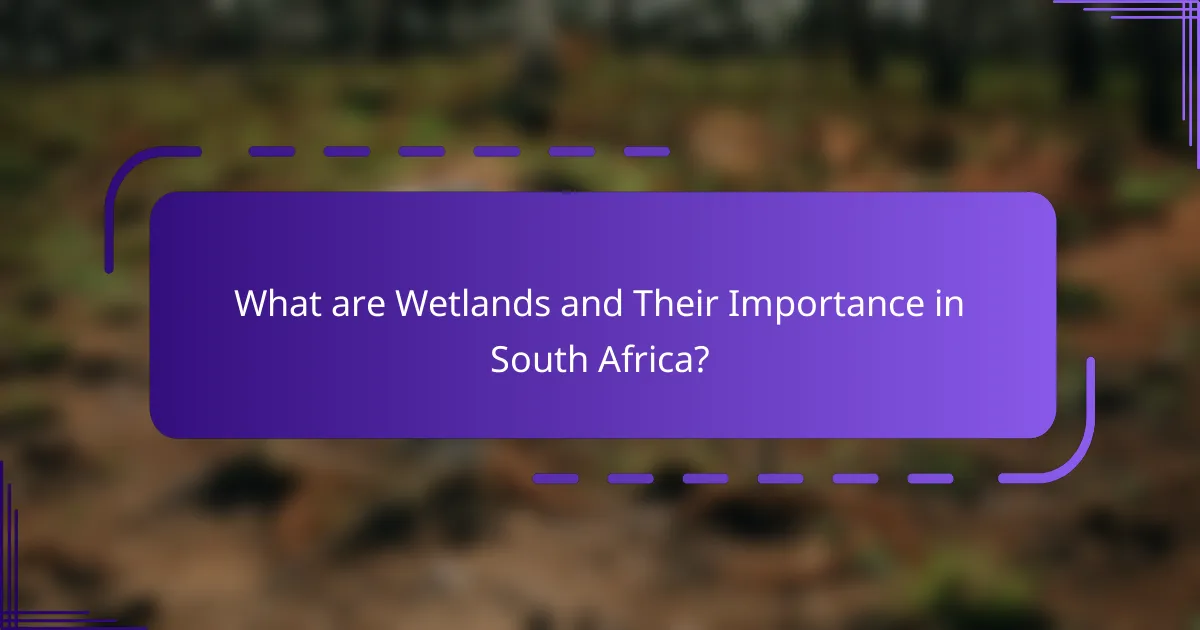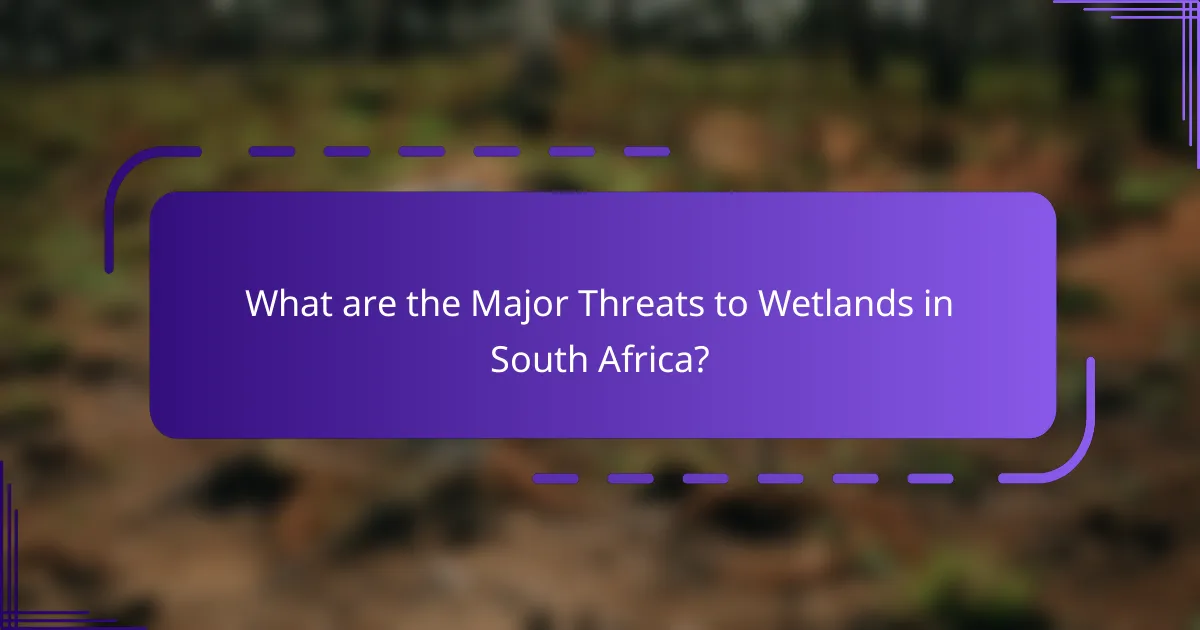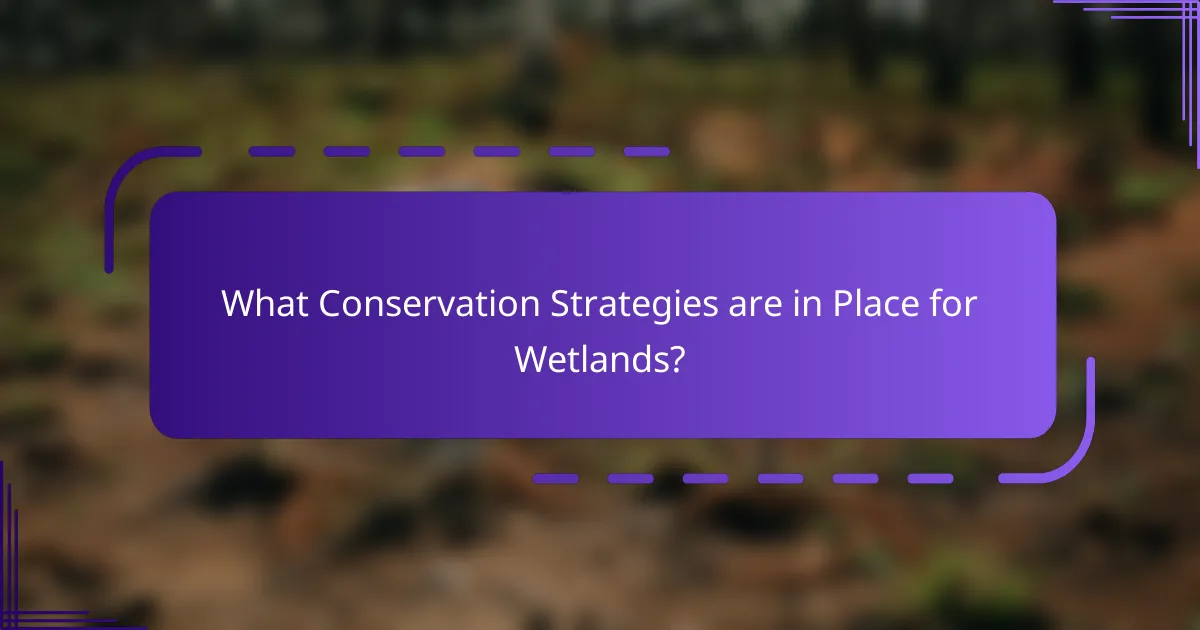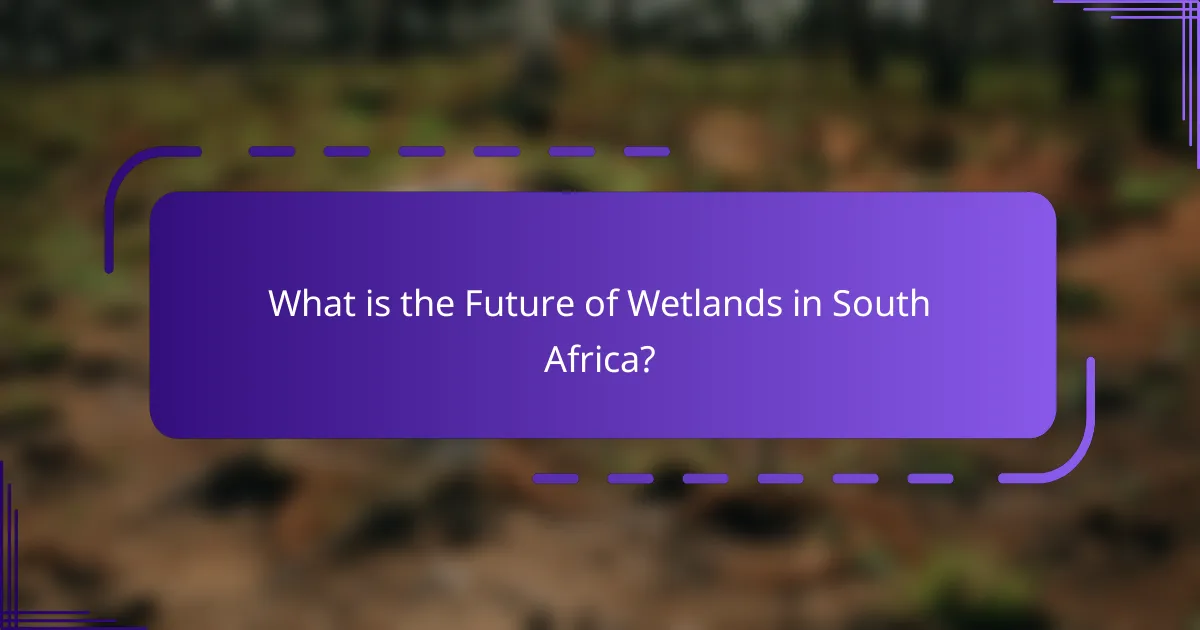Wetlands are vital ecosystems in South Africa, characterized by saturated soils, water, and unique vegetation. They provide essential services such as habitat for diverse species, natural water filtration, flood control, and carbon storage, which contribute to climate change mitigation and food security. However, wetlands face significant threats from urban development, agriculture, pollution, and climate change, leading to habitat loss and degradation. Conservation strategies, including legal protection, restoration projects, and sustainable management practices, are crucial for preserving these ecosystems and their biodiversity. The future health of South Africa’s wetlands depends on effective implementation of these strategies to combat ongoing threats and ensure the sustainability of these important areas.

What are Wetlands and Their Importance in South Africa?
Wetlands are ecosystems characterized by saturated soils, water, and distinct vegetation. They play a crucial role in South Africa’s environment. Wetlands provide habitat for diverse flora and fauna. They also act as natural water filters, improving water quality. Additionally, wetlands help in flood control by absorbing excess rainfall. They store carbon, contributing to climate change mitigation. In South Africa, wetlands support agriculture and fisheries, enhancing food security. Protecting these areas is vital for biodiversity and ecosystem health.
How do wetlands function as ecosystems?
Wetlands function as ecosystems by providing critical habitats for diverse plant and animal species. They act as natural water filters, improving water quality by trapping pollutants. Wetlands also store floodwaters, reducing the risk of flooding in surrounding areas. They play a significant role in carbon sequestration, helping to mitigate climate change effects. Additionally, wetlands support nutrient cycling, which is essential for maintaining biodiversity. In South Africa, wetlands are crucial for sustaining fisheries and agricultural productivity. According to the South African National Biodiversity Institute, wetlands are home to over 30% of the country’s plant species. This highlights their importance in maintaining ecological balance and supporting livelihoods.
What are the key characteristics of wetlands?
Wetlands are unique ecosystems characterized by saturated soil, standing water, and specific vegetation. They support diverse plant and animal life adapted to wet conditions. Wetlands can be freshwater, saltwater, or brackish. They play a crucial role in water filtration and flood control. Wetlands also provide habitats for numerous species, including migratory birds. According to the Ramsar Convention, wetlands cover about 6% of the Earth’s surface. They are vital for biodiversity and ecosystem services.
What roles do wetlands play in water management?
Wetlands play crucial roles in water management. They act as natural sponges, absorbing excess rainfall and reducing flood risks. Wetlands filter pollutants from water, improving water quality for ecosystems and human use. They also recharge groundwater supplies by allowing water to percolate through the soil. Additionally, wetlands provide habitat for diverse species, contributing to biodiversity. According to the Ramsar Convention, wetlands can store significant amounts of carbon, helping mitigate climate change effects. Therefore, their preservation is vital for sustainable water management practices.
What ecosystem services do wetlands provide?
Wetlands provide essential ecosystem services including water filtration, flood regulation, and habitat support. They filter pollutants from water, improving water quality. Wetlands also store excess rainwater, reducing flood risks in surrounding areas. Additionally, they serve as critical habitats for diverse wildlife, supporting biodiversity. According to the Ramsar Convention, wetlands are vital for maintaining ecological balance. They also sequester carbon, helping mitigate climate change effects. These services underscore the importance of wetland conservation in South Africa’s ecosystem.
How do wetlands contribute to biodiversity?
Wetlands contribute to biodiversity by providing essential habitats for a diverse range of species. They support aquatic plants, insects, amphibians, birds, and mammals. Wetlands serve as breeding grounds and feeding areas for many species. They also act as filters, improving water quality and supporting healthy ecosystems. According to the South African National Biodiversity Institute, wetlands are home to approximately 40% of the world’s plant and animal species. This high level of species richness is crucial for ecological balance. Wetlands also facilitate nutrient cycling, which supports various life forms. Their unique hydrology creates microhabitats that foster diverse biological communities.
What benefits do wetlands offer for climate regulation?
Wetlands provide significant benefits for climate regulation. They act as carbon sinks, sequestering large amounts of carbon dioxide from the atmosphere. This process helps mitigate climate change by reducing greenhouse gases. Wetlands also regulate local climate conditions by maintaining humidity and temperature. They influence rainfall patterns through evapotranspiration, contributing to regional climate stability. According to the Ramsar Convention, wetlands can store up to 30% of the world’s carbon. This storage capacity highlights their importance in climate regulation efforts globally.
How do wetlands support local economies?
Wetlands support local economies through various ecosystem services. They provide water resources for agriculture and fishing industries. Wetlands also offer recreational opportunities that boost tourism. This tourism generates income and creates jobs in local communities. Additionally, wetlands help in flood control, reducing economic losses from natural disasters. They improve water quality, which is vital for health and agriculture. According to the South African National Biodiversity Institute, wetlands contribute significantly to livelihoods. Their preservation is crucial for sustaining these economic benefits.

What are the Major Threats to Wetlands in South Africa?
The major threats to wetlands in South Africa include urban development, agriculture, and pollution. Urban development leads to habitat destruction and fragmentation. Agriculture often results in the drainage of wetlands for crop production. Pollution from industrial and agricultural runoff degrades water quality. Invasive species also threaten native wetland flora and fauna. Climate change exacerbates these threats by altering water availability and increasing temperatures. According to the South African National Biodiversity Institute, wetland loss has significant ecological and economic impacts.
How does urban development impact wetlands?
Urban development negatively impacts wetlands by causing habitat loss and degradation. Construction activities often fill or drain wetlands for land use. This reduces biodiversity, as many species rely on wetlands for survival. Urban runoff introduces pollutants into wetlands, harming water quality. Increased impervious surfaces lead to altered hydrology, affecting natural water flow. According to the South African National Biodiversity Institute, urbanization has significantly decreased wetland areas in South Africa. This results in diminished ecosystem services such as flood regulation and water purification.
What specific examples illustrate urban threats to wetlands?
Urban threats to wetlands include pollution, habitat destruction, and invasive species. Pollution often arises from stormwater runoff containing chemicals and waste. This runoff can degrade water quality and harm aquatic life. Habitat destruction occurs due to urban development, leading to the loss of wetland areas. Construction projects frequently fill or drain wetlands for land use. Invasive species, introduced through urban areas, can outcompete native flora and fauna. These species disrupt the ecosystem balance, further threatening wetland health. Collectively, these factors significantly impact the ecological functions of wetlands.
How does pollution affect wetland health?
Pollution negatively impacts wetland health by degrading water quality and harming biodiversity. Contaminants such as heavy metals, pesticides, and nutrients can accumulate in wetland ecosystems. This accumulation leads to toxic conditions for aquatic life. Additionally, excess nutrients can cause algal blooms, which deplete oxygen levels. Low oxygen levels result in fish kills and loss of other aquatic organisms. Furthermore, pollutants disrupt the natural balance of wetland habitats. Studies show that polluted wetlands experience reduced plant diversity and altered species composition. These changes ultimately diminish the ecosystem services wetlands provide, such as water filtration and flood control.
What are the effects of climate change on wetlands?
Climate change adversely affects wetlands by altering their hydrology, leading to increased flooding and drought. These changes disrupt the delicate balance of water levels necessary for the survival of wetland ecosystems. Rising temperatures can also result in shifts in plant and animal species composition, threatening biodiversity. Additionally, increased carbon dioxide levels can enhance plant growth but may also lead to the proliferation of invasive species. According to the Intergovernmental Panel on Climate Change (IPCC), wetlands are particularly vulnerable to climate impacts, which can result in habitat loss and decreased ecosystem services.
How does changing precipitation influence wetland ecosystems?
Changing precipitation significantly impacts wetland ecosystems. Variations in rainfall alter water levels in wetlands. Increased precipitation can lead to flooding, which may disrupt plant and animal habitats. Conversely, reduced precipitation can cause drought, leading to habitat loss and decreased biodiversity. Wetlands rely on a delicate balance of water to maintain their ecological functions. For instance, in South Africa, changes in precipitation patterns have been linked to climate change. This has resulted in shifts in species composition and nutrient cycling within these ecosystems. Studies indicate that altered hydrology can affect the ability of wetlands to filter pollutants and provide habitat for wildlife.
What are the long-term implications of climate change for wetland biodiversity?
Climate change poses significant long-term implications for wetland biodiversity. Rising temperatures can alter species distributions and lead to habitat loss. Increased flooding and droughts can disrupt the delicate balance of wetland ecosystems. Changes in precipitation patterns may affect plant and animal life cycles. The introduction of invasive species can further threaten native biodiversity. According to the Intergovernmental Panel on Climate Change (IPCC) report, wetland areas are expected to decline by 30% due to climate impacts. This decline can lead to reduced ecosystem services, such as water filtration and carbon storage, essential for environmental health.

What Conservation Strategies are in Place for Wetlands?
Conservation strategies for wetlands include legal protection, restoration projects, and sustainable management practices. Legal protection involves designating wetlands as protected areas under national and international laws. Restoration projects aim to rehabilitate degraded wetlands to restore their ecological functions. Sustainable management practices focus on balancing human activities with the conservation of wetland ecosystems. These strategies are essential for preserving biodiversity and maintaining ecosystem services. For instance, the Ramsar Convention promotes the sustainable use of wetlands globally. In South Africa, the National Wetland Policy outlines specific measures for wetland conservation.
How are wetlands being protected in South Africa?
Wetlands in South Africa are protected through various conservation strategies and legal frameworks. The National Environmental Management Act guides the protection of these ecosystems. Additionally, the Ramsar Convention, which South Africa is a signatory to, emphasizes the importance of wetlands. Local governments implement specific management plans for wetland conservation. Restoration projects are also undertaken to rehabilitate degraded wetlands. Community involvement is encouraged to promote sustainable practices. Monitoring programs assess the health of wetland ecosystems regularly. These measures collectively aim to safeguard the biodiversity and ecosystem services provided by wetlands.
What policies support wetland conservation efforts?
Wetland conservation efforts are supported by various policies at national and international levels. The Ramsar Convention on Wetlands is a key international treaty aimed at conserving wetlands globally. In South Africa, the National Water Act of 1998 provides a legal framework for the protection of wetlands. This act emphasizes the importance of wetlands in maintaining water quality and regulating water flow. The Biodiversity Act of 2004 also supports wetland conservation by promoting the protection of ecosystems and species. Furthermore, the National Environmental Management Act guides sustainable development practices that benefit wetlands. These policies collectively aim to ensure the sustainable use and preservation of wetland ecosystems.
How do community initiatives contribute to wetland preservation?
Community initiatives contribute to wetland preservation by promoting local stewardship and awareness. These initiatives often involve community members in conservation activities. For example, local groups may organize clean-up events to remove debris from wetlands. They also educate residents on the ecological importance of wetlands. This education can lead to increased public support for conservation policies. Furthermore, community-led monitoring programs can track wetland health over time. Research shows that engaged communities are more likely to adopt sustainable practices. A study by the South African National Biodiversity Institute found that local involvement enhances the effectiveness of wetland conservation efforts.
What role do NGOs play in wetland conservation?
NGOs play a crucial role in wetland conservation by advocating for policies and practices that protect these ecosystems. They conduct research to assess wetland health and biodiversity. NGOs also engage in community education to raise awareness about the importance of wetlands. They often collaborate with governmental agencies to implement conservation strategies. Funding from NGOs supports restoration projects that enhance wetland habitats. Many NGOs monitor wetland conditions and report on environmental changes. Their efforts contribute to the preservation of biodiversity and ecosystem services provided by wetlands. For example, the World Wildlife Fund has initiated projects that restore degraded wetlands in South Africa, highlighting the effectiveness of NGO involvement in conservation.
What successful conservation projects have been implemented?
Successful conservation projects in South Africa include the Working for Wetlands program. This initiative aims to restore and rehabilitate wetland ecosystems. It has led to the improved health of numerous wetlands across the country. The program has created thousands of job opportunities for local communities. Additionally, the Ramsar Convention has designated several South African wetlands as protected sites. These designations help to conserve biodiversity and promote sustainable use of resources. The success of these projects is evidenced by increased species diversity and improved water quality in restored areas.
How can public awareness campaigns enhance wetland protection?
Public awareness campaigns can enhance wetland protection by educating communities about the importance of wetlands. These campaigns inform the public about ecosystem services provided by wetlands, such as water filtration and flood control. Increased knowledge leads to greater community engagement in conservation efforts. For instance, studies show that informed citizens are more likely to participate in local conservation initiatives. Additionally, awareness campaigns can mobilize support for policy changes that protect wetlands. They can also foster a sense of stewardship among residents. Overall, effective campaigns can significantly reduce threats to wetland ecosystems.

What is the Future of Wetlands in South Africa?
The future of wetlands in South Africa is at risk due to climate change and urban development. Wetlands provide essential ecosystem services, including water purification and flood control. However, increasing pollution and habitat loss threaten these areas. A significant portion of South Africa’s wetlands has already been degraded, with estimates suggesting that up to 50% of original wetlands are lost. Conservation efforts are critical for restoring and protecting remaining wetlands. Strategies include sustainable land-use practices and community engagement. Legislative frameworks also aim to enhance wetland protection. The success of these initiatives will determine the future health and viability of wetlands in South Africa.
How can sustainable practices improve wetland health?
Sustainable practices can significantly improve wetland health by enhancing biodiversity and water quality. These practices include restoring native vegetation, which stabilizes soil and reduces erosion. Additionally, implementing controlled water management helps maintain optimal water levels for aquatic life. Reducing pollution through sustainable agricultural practices minimizes nutrient runoff into wetlands. This leads to healthier ecosystems that support diverse species. Studies show that wetlands managed sustainably can increase carbon sequestration by up to 30%. Therefore, sustainable practices not only protect wetland health but also contribute to climate change mitigation.
What are the best practices for managing wetland resources?
Best practices for managing wetland resources include implementing sustainable land-use practices, restoring degraded wetlands, and monitoring water quality. Sustainable land-use practices minimize pollution and habitat destruction. Restoration of degraded wetlands enhances ecosystem functions and biodiversity. Regular monitoring of water quality ensures that pollutants are identified and addressed promptly. Additionally, engaging local communities in conservation efforts fosters stewardship and sustainable use. Education and awareness programs further support the protection of wetland resources. These practices collectively contribute to the health and sustainability of wetland ecosystems.
How can technology aid in wetland conservation efforts?
Technology aids in wetland conservation efforts through remote sensing, data analytics, and modeling tools. Remote sensing enables the monitoring of wetland health and changes over time. Satellite imagery provides real-time data on vegetation cover and water levels. Data analytics processes this information to identify trends and threats. Modeling tools simulate the impact of various conservation strategies. Geographic Information Systems (GIS) map wetland areas and assess habitat quality. Drones offer aerial surveys for detailed assessments. These technologies enhance decision-making for effective conservation practices.
What actions can individuals take to support wetland conservation?
Individuals can support wetland conservation by participating in local restoration projects. These projects often involve planting native vegetation and removing invasive species. Engaging in community clean-up events helps reduce pollution in wetland areas. Educating others about the importance of wetlands promotes awareness and advocacy. Supporting organizations focused on wetland conservation through donations or volunteering strengthens their efforts. Advocating for policies that protect wetlands at local and national levels can lead to significant changes. Reducing water usage and practicing responsible landscaping can minimize runoff and protect wetland ecosystems. Lastly, reporting illegal activities, such as dumping or development, helps enforce conservation laws.
How can community involvement make a difference?
Community involvement can significantly enhance wetland conservation efforts. Engaged communities contribute local knowledge and resources. This collaboration leads to more effective management strategies. For instance, studies show that community-led initiatives can improve biodiversity outcomes. In South Africa, community involvement has led to successful rehabilitation projects. These projects often result in increased awareness and advocacy for wetland preservation. Furthermore, local participation fosters a sense of ownership and responsibility. This can lead to sustainable practices that protect these vital ecosystems.
What simple changes can individuals implement in their daily lives?
Individuals can implement simple changes to support wetland conservation. Reducing water usage at home can lessen the strain on local wetlands. Using native plants in gardens promotes local biodiversity. Avoiding chemical fertilizers protects wetland water quality. Participating in local clean-up events helps maintain wetland health. Supporting sustainable agricultural practices reduces runoff into wetlands. Educating others about wetland importance fosters community awareness. These actions contribute to the preservation of vital wetland ecosystems.
The primary entity of this article is wetlands in South Africa, which are essential ecosystems characterized by saturated soils and distinct vegetation. The article outlines the importance of wetlands, highlighting their roles in providing ecosystem services such as water filtration, flood control, and biodiversity support. It also discusses the major threats to wetlands, including urban development and pollution, and examines various conservation strategies aimed at protecting these vital areas. Furthermore, the article emphasizes the significance of community involvement and sustainable practices in enhancing wetland health and ensuring their future viability.